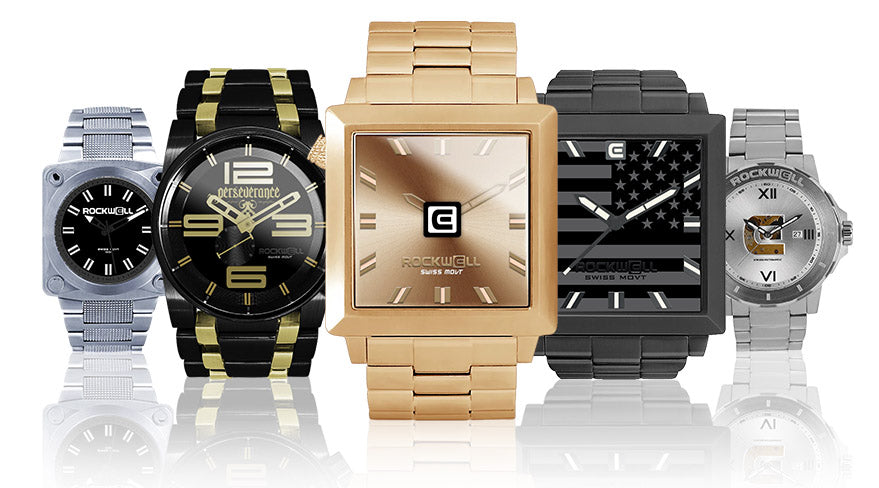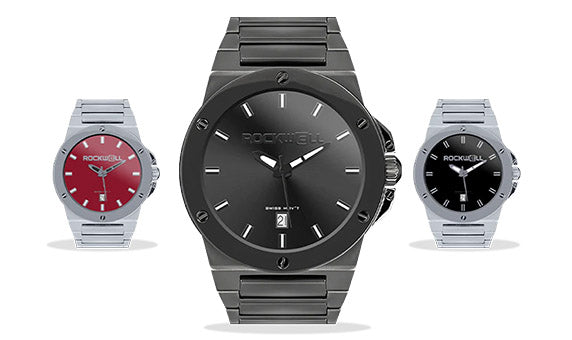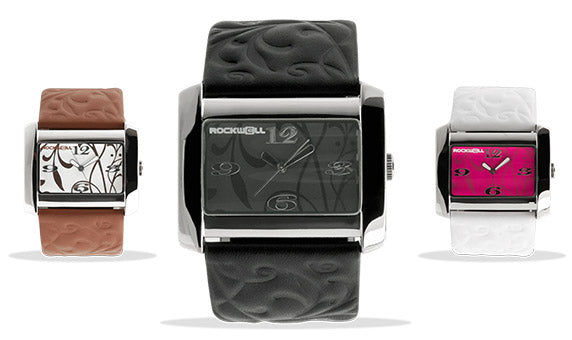Analog Watches

At Rockwell, our line of analog watches features luxury timepieces that have been handcrafted with unmatched precision and detail. While some might see these classic timekeepers as a thing of the past, we’ve fused timeless tradition with innovative features, mechanics, and designs to create an accessory that stands the test of time (and tells it with impeccable accuracy, too).
What is an Analog Watch?
An analog watch is a timekeeping device that uses mechanical hands (hour, minute, and sometimes second) to show the time. Rather than using electronic displays like smartwatches or digital timepieces, analog watches are run by the movement of inner mechanics.
The term “analog watch” is relatively new, though the mechanics it describes have been around for centuries. It was coined when digital watches hit the scene and people needed to distinguish between watch variations. No longer could you just call a watch a watch and expect folks to know what you were referring to.
Key Features of an Analog Watch
Watch Movement: An analog watch can use different types of movements, including automatic (self-winding mechanical) and quartz movement. Automatic watches use the movement of the wearer’s wrist to keep the mechanics wound and moving. This is not to be confused with mechanical watches, which are powered by the inner mainspring and must be wound frequently. Finally, quartz watches draw their movement from a battery which powers a quartz crystal for precision timekeeping.
Hour and Minute Hands: These watches feature an hour hand, which points to the numbered hour markers on the watch dial, and a minute hand, which shows the precise minute of the current hour. They can also feature a seconds hand for increased accuracy. An analog watch’s hands are generally made with thin, lightweight materials that can move quickly and effortlessly around the face.
Watch Dial: The watch’s face is also known as the dial, and it features the markers or numerals that indicate hours. Dial design can vary substantially. Some display simple lines or a few key numbers, while others boast ornate Roman numerals for each hour.
Fire Up the Time Machine: The History of the Analog Watch
The analog watch isn’t simply a fashion trend, here today and gone tomorrow, it’s a piece of history. Since the dawn of time, human beings have been searching for accurate methods of time keeping. The ancient Romans, Egyptians, and Greeks developed instruments such as sundials and water clocks to record astronomical time and seasons, but these didn’t quite meet the mark. People of every vocation felt the need for a more accurate and reliable time keeping device. Finally, European artisans of the late 13th century crafted a mechanical system that showed some promise. The first models were primarily used by monasteries and cathedrals, but were still too lacking in reliability and accuracy to be used in more scientific realms.
Throughout the 14th and 15th centuries, clocks continued to evolve, eventually featuring escapements to control the rotation of the wheels and later the swinging pendulum. This time period also saw the invention of the fusee, allowing for smaller, more portable clocks by equalizing the spring’s force on the wheels when the device was wound. The integration of these mechanics into timekeeping finally allowed for a more accurate and consistent reading, which paved the way for clocks to be owned and operated by the common individual.
The first pocket watch was invented in Germany in the year 1510 by a master locksmith named Peter Henlein. These handcrafted accessories cost a pretty penny and were, therefore, only owned by the wealthy upper class. Rather than worn on a chain in a pocket, the earliest versions of these portable watches were worn around the neck, kind of like a super rad necklace. While they still boasted a brass lid to protect the inner mechanics, the inside lacked the glass screen seen on later models.
But as revolutionary as these newfangled timepieces were, their mainspring-powered mechanics still didn’t quite meet the mark where accuracy was concerned. However, once the lever escapement entered the scene, complete with a shiny new minute hand, things started looking up and the portable watch became the trusty tool it continues to be today.
The pocket watch enjoyed its time in the spotlight for three centuries. However, in the year 1810, exactly three hundred years after the invention of the pocket watch, a fashion-forward queen changed history. That’s right, wrist watches might bear the stigma of being a men’s accessory, but as is often the case, the credit goes to the ladies. Italian watchmaker Abraham-Louis Breguet crafted the first ever wrist watch for Queen Caroline Murat of Naples, and forever changed the game of time telling.
It wasn’t long before everybody who was anybody had to get their hands on one of these fancy contraptions. People saw the importance of being able to tell the time at a glance, without having to reach into their pocket, pull on a chain, and pop open a lid. Brazilian aircraft pilot and inventor Alberto Santos Dumont especially lamented the struggles and inconveniences of pocket watches. In fact, he voiced his complaints so loudly that in 1904, his friend Louis Cartier, the infamous French jeweler, designed the first men’s wristwatch (which also happened to be the first pilot’s watch).
By the time the World Wars came around, the need for easily accessible and accurate timekeeping brought about the first tactical analog watch, and pocket watches became a thing of the past. The 1920s saw the invention of automatic watches, and in 1931, Rolex rolled out the first waterproof watch.
In 1969, Seiko Astron put out the first quartz watch. The mechanics of the quartz movement watches were simpler, easier to make, and required fewer parts. This made them significantly less expensive to produce than their predecessors, which led to what watchmakers know as the Quartz Revolution. Suddenly, wrist watches could be purchased at a far cheaper price, causing a boom in the quartz market. Unfortunately, though, this caused incredible loss for watchmakers everywhere, and roughly one thousand watchmaking companies were forced to close their doors.
The Quartz Revolution lasted for about twenty years before people began to find new appreciation for the handcrafted inner workings of mechanical watches and the increased accuracy they provided. The fast-fashion-esque appeal of quartz movement watches failed to offer the longevity, functionality, and craftsmanship of traditional analog watches. Now, many analog watches feature more sophisticated quartz movement paired with the sophisticated mechanics of traditional watches. Thus, these timeless timepieces made their way back to the top, securing their title of reliable, luxury accessory once and for all.
Why Go Analog, Anyway?
But why go analog when modern technology has afforded us so many conveniences, like digital watches and smartwatches? Aren’t analog watches just for old guys with a knack for collecting or stuffy business execs in high rise offices?
If only you could see us violently shaking our heads this very moment. Absolutely not. While analogs can be a sick investment for collectors or the perfect accessory to pair with a business suit, there’s so much more to them.
The clientele that comes to us in search of the perfect analog watch is incredibly diverse. They come from all walks of life. Men, women, white collar, blue collar, military, teacher, boss babe and gym bro. But the one thing they all have in common is an appreciation for these timeless treasures. So, what makes analog watches such a coveted commodity? We’re glad you asked.
1. Timeless Style
If you’re looking for an easy and instantaneous way to up your style, the analog watch makes the perfect addition to any look. Not only does it pair well with formal and business attire, it’s sure to add sexy sophistication to any outfit. Even your trusty sweatsuit that becomes a staple between the months of October and May can be redeemed with a classy analog sports watch.
2. Mechanics You Can Count On
Analog watches are meticulously assembled by expert horologists who have a passion for superb quality and craftsmanship. The mechanics of an analog watch are the fruits of precision engineering and attention to even the smallest of details. These timepieces are known for their delicate balance of springs and gears, working together in perfect harmony within the watch movement and resulting in a level of quality that cannot be replicated or matched by their machine-assembled digital counterparts.
3. Durability and Longevity
When you picture a durable timepiece, there’s a good chance you see a bulky black sports watch that looks like it could get hit by a steam engine at full speed without batting an eye. Don’t get us wrong, we love our rough and tough digital watches. But trust us when we say that analog watches can hold their own.
For the last century, many a military professional has chosen a tactical analog watch as his (or her) tool of the trade. In addition, many of the world's most talented athletes love to showcase their analog sports watch. After all, they pair exceptionally well with shiny trophies and medals.
The handcrafted movements that have become the trademark of high-end analog watches can endure more than board meetings and funerals. With proper maintenance and care, they’ll continue to be an accessory you can count on. And thanks to durable materials such as sapphire-coated crystal and stainless steel, these worthy investments can last not just years, but for decades to come.
4. Distraction-Free Accessory
We love a digital sports watch with all the bells and whistles, and there is certainly a time and place for the host of functions and features they boast. However, with so many features right there on your wrist, some folks have found that digital watches can become quite the distraction.
And we all know that looking at a smartphone with the sole intention of checking the time can prove disastrous. That’s why many people have come to appreciate the distraction-free simplicity of analog watches. If you need to get stuff done in a timely fashion, analog might just be for you.
5. Status Symbol
When you don an analog watch from a trusted high-end watchmaker like Rockwell, you’re putting on more than just an accessory–you’re putting on an air of refinement and status. The addition of this classic timepiece lets everyone know that you have a deep appreciation for craftsmanship, tradition, and attention to detail.
Rockwell’s Analog Watches
Here at Rockwell Time, we use quality materials and precision-driven mechanics to deliver a line of analog watches that are both timeless and revolutionary. Our line-up features classic pieces for both men and women that come in all shapes, sizes, colors, and designs. Whether you’re on the hunt for an analog sports watch, the perfect accessory for your snazzy business suit, or a tactical analog watch that’s as tough as you are, we’ve got a product for you.
While we could never choose a favorite from our line of analog watches (that would be like picking a favorite child and, seriously, who does that?), we can show you a few customer favorites. These pieces have put Rockwell on the map, and we’re proud to show them off.
The 40mm² and 50mm²
If it’s a statement-making accessory you’re searching for, look no further than our 40mm or 50mm models. These square face luxury watches are truly a trend-setter with their super sleek, out-of-the-box appeal. The quality stainless steel casing of these pieces comes in black, gold, and multiple shades of silver. Now in their second generation, these watches boast a three-hand display, a sleek tapered band, and an ultra-precise Ronda Swiss 762 movement.
The Plymouth
This tactical analog watch is as tough as the heroes it was designed for. Designed and built in the USA, it doesn’t get much more American than this. In fact, it even features an Ameriquartz 7121 movement. Its scratch and shatter-resistant K1 Hardened Mineral crystal paired with 40mm surgical grade 316L stainless steel casing and anti-reflective AR coating gives this tool the durability it needs to withstand warlike wear and tear. In the meantime, its matte black design will keep you looking good in the process.
If your adventures find you in the pitch black of night, don’t worry–the glow-in-the-dark hands and markers will keep you punctual. And no matter how long the adventure, the Plymouth’s 48-month battery life makes this watch one you can depend on.
The Vanguard
Built with never-before-seen features in the Rockwell Time family of watches, the Vanguard takes “dive watch” to a whole new level. The 10 ATM water resistance and double layered nylon band make it ideal for any wilderness explorer, while its rotating bezel allows the wearer to set a manual timer. And, of course, it wouldn’t be Rockwell without that flair of American pride, so we added a tasteful US flag to the center of the face.
The Rockwell Promise
The products here at Rockwell Time offer exceptional durability and longevity. We’ve put them through the wringer in our testing procedures so that we can confidently offer one of the most generous warranties in the industry. Rockwell’s two-year warranty covers any manufacturing defects you might experience with a full product replacement within the first two years of purchase.
In addition, we’ll cover 70% of the total price whenever you decide you’d like to upgrade your Rockwell product, so you get a brand spankin’ new accessory for a mere 30% of the price.




















